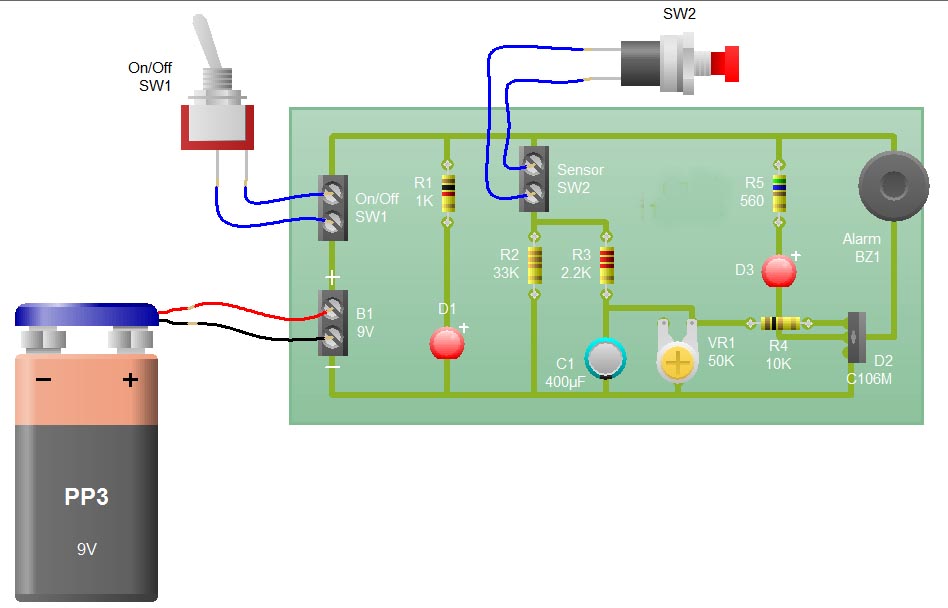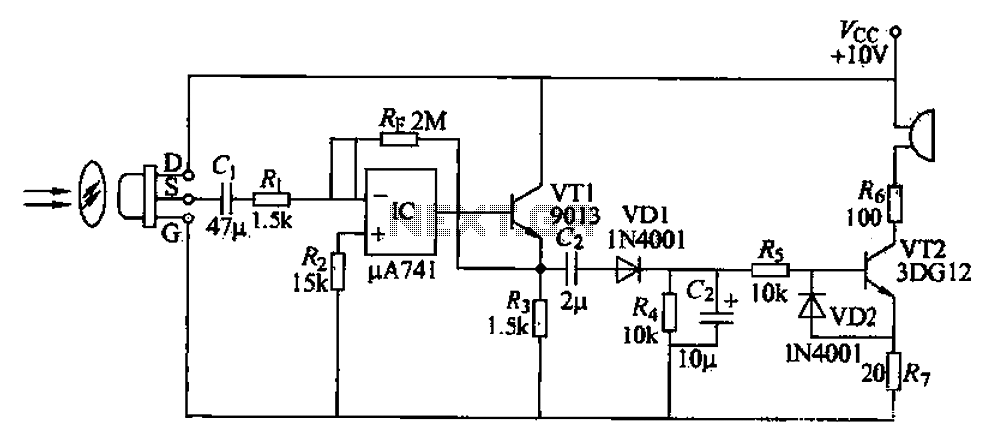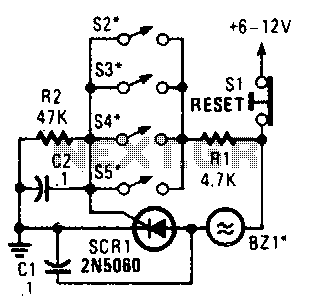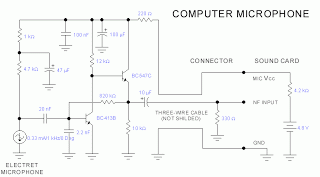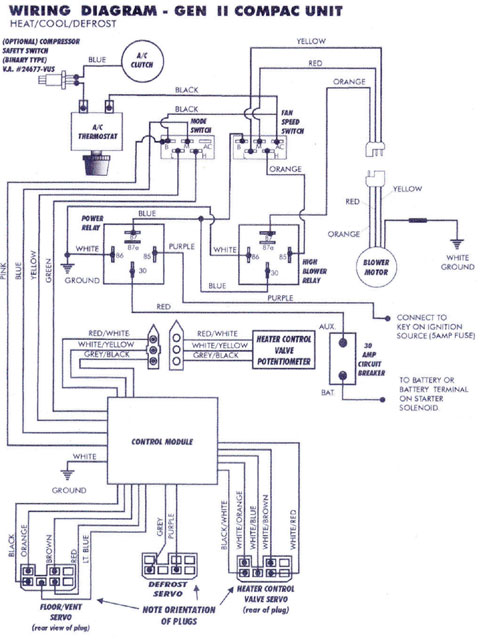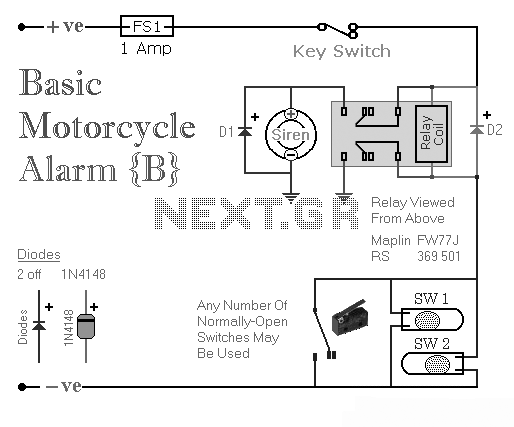
Car Alarm and Immobilizer

This circuit includes exit and entry delays, an instant alarm zone, an intermittent siren output, and an automatic reset feature. By incorporating external relays, it is possible to immobilize the vehicle and flash the lights. The alarm is activated by opening switch Sw1, which can be any small 1-amp single-pole change-over switch; however, for enhanced security, a key-switch may be utilized. Once Sw1 is opened, there is a 10 to 15-second window to exit the vehicle and close the door. Upon returning and opening the door, a buzzer will sound, providing another 10 to 15 seconds to deactivate Sw1. Failure to do so will trigger the siren, which operates intermittently, controlled by capacitor C6 and resistor R10. If any trigger switch remains closed, the siren will continue to sound. The circuit will reset approximately 2 to 3 minutes after all switches have been opened. One input connects to the vehicle's existing door switches to provide the necessary delays. Typically, a single wire can be connected to one door switch, as they are usually wired in parallel with a return through the chassis. Additional normally-open switches can be added to the door circuit, but they must be rated to handle the current required by the vehicle's interior light. Any number of normally-open switches may be connected in parallel to the "Instant" input, allowing for instant alarms on various vehicle parts, such as the bonnet, boot, rear hatch, or rear doors. A second switch can be fitted to the instant input to override the delay circuit. The chassis can be used for the return, but a ground terminal is available if a separate return wire is needed. If the instant zone is not utilized, components Q2, R3, R4, R5, and D3 should be omitted. The exit delay is determined by R1 and C1, the entry delay by R9 and C4, and the reset time by R7 and C3. The exact duration of these time periods depends on the specific characteristics of the components used, particularly the tolerances of the capacitors and the switching points of the CMOS gates. However, precise timing is not critical for this application. It is essential to protect the circuit board and switches from environmental factors, as moisture can lead to malfunctions. A 1-amp in-line fuse should be installed as close to the power source as possible for protection of the wiring, not the alarm itself. Installation specifics will vary based on the vehicle model, and further installation advice cannot be provided. The circuit is designed to utilize an electronic siren drawing between 300 to 400 mA. Using the vehicle's horn is generally not recommended due to its accessibility for disconnection. If the horn is chosen, a suitably rated relay must be connected to the "Siren" output to handle the current. Prior to installation, consider the safety implications of potential failures and the legal consequences of installing a device that could cause accidents. High-quality materials and workmanship are necessary to ensure reliability, particularly for the relay, which must be rated to handle the current required by the ignition system. A relay designed for automotive use is recommended for optimal protection against environmental factors and long-term reliability.
The circuit operates by integrating several key components that work collaboratively to provide a comprehensive vehicle security solution. The primary control mechanism is the switch Sw1, which initiates the alarm system. Upon activation, the system enters a delay mode, allowing the user to exit the vehicle. The exit delay is adjustable through resistor R1 and capacitor C1, which define the timing characteristics. The entry delay, similarly adjustable via resistor R9 and capacitor C4, ensures that the user has adequate time to disarm the system upon returning.
The alarm system features an instant alarm zone, which can be activated by additional normally-open switches placed at strategic locations, such as the bonnet or doors. This zone operates independently of the exit and entry delays and provides immediate notification if unauthorized access is attempted. The intermittent siren output, controlled by C6 and R10, serves to deter intruders by producing a loud sound that varies in intensity.
In terms of power management, the circuit requires careful consideration of the fuse placement to prevent damage to the wiring. The choice of siren is also critical; an electronic siren is preferred for its reliability and power consumption characteristics. If the vehicle's horn is utilized, a relay must be employed to ensure that the alarm can handle the higher current demands.
Environmental protection is paramount; therefore, the circuit board and switches should be housed in a weather-resistant enclosure to prevent moisture ingress. The grounding system is flexible, allowing for either a chassis ground or a separate return wire, depending on installation requirements.
Overall, the design emphasizes reliability, user-friendliness, and adaptability to different vehicle configurations, making it a robust solution for vehicle security.This circuit features exit and entry delays, an instant alarm zone, an intermittent siren output and automatic reset. By adding external relays you can immobilize the vehicle and flash the lights. The alarm is "set" by opening Sw1. It can be any small 1-amp single-pole change-over switch - but for added security you could use a key-switch.
Once Sw1 is opened you have about 10 to 15 seconds to get out of the vehicle and close the door behind you. When you return and open the door the buzzer will sound. You have 10 to 15 seconds to move Sw1 to the "off" position. If you fail to do so, the siren will sound. The output to the siren is intermittent - it switches on and off. The speed at which it switches on and off is set by C6 and R10. While any trigger-switch remains closed, the siren will continue to sound. About 2 to 3 minutes after all of the switches have been opened, the circuit will reset. One of the inputs is connected to the vehicle`s existing door-switches. This provides the necessary exit and entry delays. It`s usually sufficient to connect a SINGLE wire to just ONE of the door switches - they`re generally all connected in parallel with the return through the chassis. You can add extra normally-open switches to the door-circuit if you wish; but note that any additional switches will have to be able to carry the current required by your vehicle`s interior light.
Any number of normally-open switches may be connected - in parallel - to the "Instant" input. Since they don`t have to carry the current for the interior light, you can use any type of switch you like. You may want an instant alarm on the bonnet, the boot, the rear-hatch, the rear-doors etc. It doesn`t matter if these already have switches connected to the door-circuit. Simply fit a second switch and connect it to the instant input. It will override the delay circuit. You can use the chassis for the return. However, a ground terminal is provided if - for any reason - you need to run a separate return wire for either zone.
If you`re not using the instant zone then leave out Q2, R3, R4, R5 & D3. The exit delay is set by R1 & C1, the entry delay by R9 & C4, and the reset time by R7 & C3. The precise length of any time period depends on the characteristics of the actual components used - especially the tolerance of the capacitors and the exact switching points of the Cmos Gates. However, for this type of application really accurate time periods are unnecessary. The circuit board and switches must be protected from the elements. Dampness or condensation will cause malfunction. Fit a 1-amp in-line fuse AS CLOSE AS POSSIBLE to your power source. This is VERY IMPORTANT. The fuse is there to protect the wiring - not the alarm. Exactly how the system is fitted will depend on the make of your particular vehicle. Consequently, I CANNOT give any further advice on installation. The circuit is designed to use an electronic Siren drawing 300 to 400mA. It`s not usually a good idea to use the vehicle`s own Horn because it can be easily located and disconnected.
However, if you choose to use the Horn, remember that the alarm relay is too small to carry the necessary current. Connect the coil of a suitably rated relay to the "Siren" output. This can then be used to sound the Horn, flash the lights etc. Before fitting this immobilizer to your vehicle, carefully consider both the safety implications of its possible failure - and the legal consequences of installing a device that could cause an accident.
If YOU decide to proceed, you will need to use the highest standard of materials and workmanship. Remember that the relay MUST be large enough to handle the current required by your ignition system. Choose one specifically designed for automobiles - it will be protected against the elements and will give the best long-term reliability. You don`t want it to let you down on a cold wet night - or worse still - in fast moving 🔗 External reference
The circuit operates by integrating several key components that work collaboratively to provide a comprehensive vehicle security solution. The primary control mechanism is the switch Sw1, which initiates the alarm system. Upon activation, the system enters a delay mode, allowing the user to exit the vehicle. The exit delay is adjustable through resistor R1 and capacitor C1, which define the timing characteristics. The entry delay, similarly adjustable via resistor R9 and capacitor C4, ensures that the user has adequate time to disarm the system upon returning.
The alarm system features an instant alarm zone, which can be activated by additional normally-open switches placed at strategic locations, such as the bonnet or doors. This zone operates independently of the exit and entry delays and provides immediate notification if unauthorized access is attempted. The intermittent siren output, controlled by C6 and R10, serves to deter intruders by producing a loud sound that varies in intensity.
In terms of power management, the circuit requires careful consideration of the fuse placement to prevent damage to the wiring. The choice of siren is also critical; an electronic siren is preferred for its reliability and power consumption characteristics. If the vehicle's horn is utilized, a relay must be employed to ensure that the alarm can handle the higher current demands.
Environmental protection is paramount; therefore, the circuit board and switches should be housed in a weather-resistant enclosure to prevent moisture ingress. The grounding system is flexible, allowing for either a chassis ground or a separate return wire, depending on installation requirements.
Overall, the design emphasizes reliability, user-friendliness, and adaptability to different vehicle configurations, making it a robust solution for vehicle security.This circuit features exit and entry delays, an instant alarm zone, an intermittent siren output and automatic reset. By adding external relays you can immobilize the vehicle and flash the lights. The alarm is "set" by opening Sw1. It can be any small 1-amp single-pole change-over switch - but for added security you could use a key-switch.
Once Sw1 is opened you have about 10 to 15 seconds to get out of the vehicle and close the door behind you. When you return and open the door the buzzer will sound. You have 10 to 15 seconds to move Sw1 to the "off" position. If you fail to do so, the siren will sound. The output to the siren is intermittent - it switches on and off. The speed at which it switches on and off is set by C6 and R10. While any trigger-switch remains closed, the siren will continue to sound. About 2 to 3 minutes after all of the switches have been opened, the circuit will reset. One of the inputs is connected to the vehicle`s existing door-switches. This provides the necessary exit and entry delays. It`s usually sufficient to connect a SINGLE wire to just ONE of the door switches - they`re generally all connected in parallel with the return through the chassis. You can add extra normally-open switches to the door-circuit if you wish; but note that any additional switches will have to be able to carry the current required by your vehicle`s interior light.
Any number of normally-open switches may be connected - in parallel - to the "Instant" input. Since they don`t have to carry the current for the interior light, you can use any type of switch you like. You may want an instant alarm on the bonnet, the boot, the rear-hatch, the rear-doors etc. It doesn`t matter if these already have switches connected to the door-circuit. Simply fit a second switch and connect it to the instant input. It will override the delay circuit. You can use the chassis for the return. However, a ground terminal is provided if - for any reason - you need to run a separate return wire for either zone.
If you`re not using the instant zone then leave out Q2, R3, R4, R5 & D3. The exit delay is set by R1 & C1, the entry delay by R9 & C4, and the reset time by R7 & C3. The precise length of any time period depends on the characteristics of the actual components used - especially the tolerance of the capacitors and the exact switching points of the Cmos Gates. However, for this type of application really accurate time periods are unnecessary. The circuit board and switches must be protected from the elements. Dampness or condensation will cause malfunction. Fit a 1-amp in-line fuse AS CLOSE AS POSSIBLE to your power source. This is VERY IMPORTANT. The fuse is there to protect the wiring - not the alarm. Exactly how the system is fitted will depend on the make of your particular vehicle. Consequently, I CANNOT give any further advice on installation. The circuit is designed to use an electronic Siren drawing 300 to 400mA. It`s not usually a good idea to use the vehicle`s own Horn because it can be easily located and disconnected.
However, if you choose to use the Horn, remember that the alarm relay is too small to carry the necessary current. Connect the coil of a suitably rated relay to the "Siren" output. This can then be used to sound the Horn, flash the lights etc. Before fitting this immobilizer to your vehicle, carefully consider both the safety implications of its possible failure - and the legal consequences of installing a device that could cause an accident.
If YOU decide to proceed, you will need to use the highest standard of materials and workmanship. Remember that the relay MUST be large enough to handle the current required by your ignition system. Choose one specifically designed for automobiles - it will be protected against the elements and will give the best long-term reliability. You don`t want it to let you down on a cold wet night - or worse still - in fast moving 🔗 External reference
